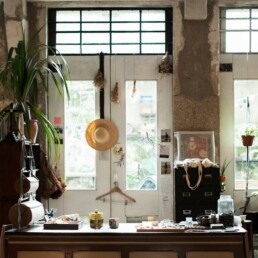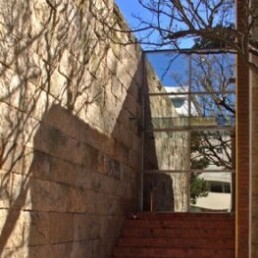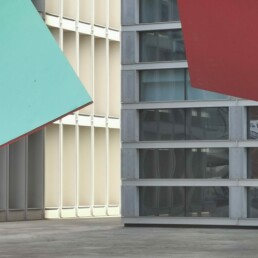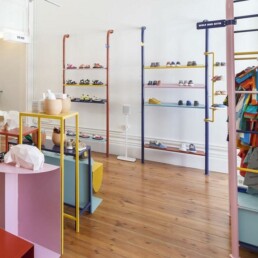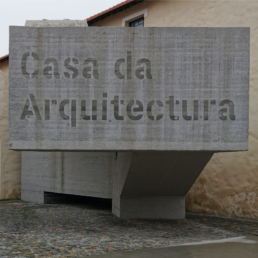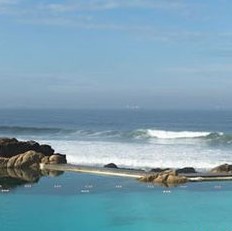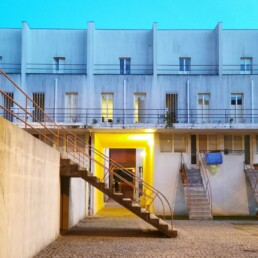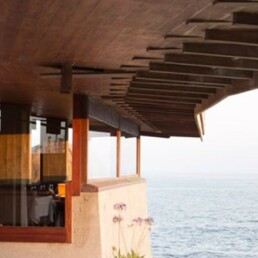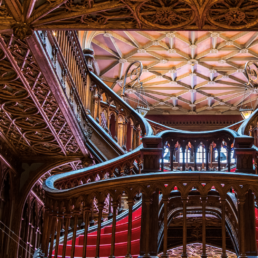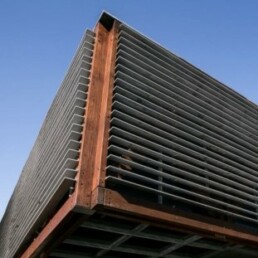Tagline
Reispas voor Porto
Porto is de tweede grootste stad van Portugal waar je ondergedompeld wordt in een ontspannen, zuiderse sfeer. Wandel door de nauwe, steile steegjes in de Ribeira wijk en snuif het unieke karakter op van de portostad. De kleurrijke authentieke huizen met typische ‘azulejos’, de open pleinen en de prachtige Dom Luisbrug behoren niet voor niets tot het Unesco-werelderfgoed.
Praktische info en tips
xxx
CORACÃO ALECRIM
Een winkel boordevol spulletjes en kleding waarbij de focus ligt op duurzaamheid en liefde voor de natuur. Alles wat je hier vind is fair-trade, handgemaakt en van lokale bodem. Bovendien zijn alle producten een streling voor het oog door hun eenvoud.
A shop full of items where the focus is on sustainability and love of nature. Everything you find here is fair-trade, handmade and from local soil. What’s more, all the products are a delight to the eye because of their simplicity.
CASA DES ARTES
In 1991 voltooide de grote architect Souto De Moura zijn eerste project, de Casa des Artes. Deze culturele plek is gebouwd tegenover Casa Allen gebouwd door architect José Marques da Silva in 1927. Het complex bestaat uit twee zalen voor concerten en conferenties met tussenin een grote tentoonstellingsruimte. Ondergronds bevindt zich ook nog een serviceruimte. Wat centraal staat bij de architectuur van het gebouw is, de eenvoud en integratie met het domein errond. Sinds 2012 is het volledige domein met de grote tuinen en Casa Allen inbegrepen geclassificeerd als monument van openbaar belang. Architectuur rondleidingen in groep kunnen gevolgd worden via Cultour. Voor groepen van 10 tot 25 personen betaal je €5 en voor groepen van 26 tot 40 personen slecht €4.
In 1991, the great architect Souto De Moura completed his first project, the Casa des Artes. This cultural site was built opposite Casa Allen by the architect José Marques da Silva in 1927. The complex consists of two halls for concerts and conferences with a large exhibition space in between. Underground there is also a service area. What is central to the architecture of the building is its simplicity and integration with the estate around it. Since 2012, the entire domain with its large gardens and Casa Allen included has been classified as a monument of public interest. Architectural tours in groups can be followed via Cultour. For groups of 10 to 25 people you pay €5 and for groups of 26 to 40 people only €4.
EARLY MADE
In een industrieel pand in het hartje van het Art district van Porto bevind zich de concept store Early Made. Een combo van een mode en lifestyle winkel en een artistiek platform. Wat zowel de kunst, vintage-design, boeken, kleding etc. die ze tentoonstellen en verkopen gemeen hebben is het hedendaagse “made in Portugal” gegeven.
The Early Made concept store is located in an industrial building in the heart of Porto’s Art district. A combo of a fashion and lifestyle shop and an artistic platform. What art, vintage design, books, clothing etc. they exhibit and sell have in common is the contemporary “made in Portugal” concept.
TORRE BURGO
Wederom een project van architect Souto De Moura. Dit project werd door de jury van de Pirtzker prijs beschreven als “…twee gebouwen naast elkaar, één verticaal en één horizontaal met verschillende schalen, in dialoog met elkaar en het stadslandschap.” Met een knipoog naar de architectuur van Mies Van Der Rohe worden de hoogtes modulair uitgedrukt en wordt er nog steeds rekening gehouden met de richting van de zon. De 17 verdiepingen van het verticale gebouw zitten verstopt achter een gevelstructuur die het gebouw hoger doet lijken dat het werkelijk is. Het lage gebouw gaat meer op in zijn omgeving terwijl het hoge gebouw roept naar meer hoge gebouwen in de omgeving nu nog laag bebouwde omgeving. Wat ook noemenswaardig is, is het kunstwerk van Ângelo de Sousa dat voor de gebouwen staat. Het project dateert van 2007.
Another project by architect Souto De Moura. This project was described by the jury of the Pirtzker Prize as “…two buildings next to each other, one vertical and one horizontal with different scales, in dialogue with each other and the urban landscape”. With a nod to the architecture of Mies Van Der Rohe, the heights are expressed in a modular way and the direction of the sun is still taken into account. The 17 floors of the vertical building are hidden behind a facade structure that makes the building appear higher than it really is. The low building blends in more with its surroundings while the tall building calls out to more tall buildings in the area that are still low.
The project was completed in 2007. What is also worth mentioning is the work of art by Ângelo de Sousa that stands in front of the buildings.
THE FEETING ROOM
Een samenwerking tussen verschillende merken dat ondertussen een keten van 3 conceptstores in Portugal (waarvan 2 in Porto) is geworden. Wat begon als voornamelijk een schoenenwinkel is nu uitgebouwd tot een concept waarbij lokale en zelfstandige merken van kleding, schoenen en huisspullen gepromoot worden. Tijdens een dagje uit kan je in beiden filialen ook even tot rust komen in hun binnenplaats dat is omgetoverd tot gezellig café voor zowel brunch en koffie als apéro met cocktails.
A collaboration between different brands that has now become a chain of 3 concept stores in Portugal (of which 2 in Porto). What started as mainly a shoe shop has now developed into a concept promoting local and independent brands. During a day out you can also relax in both branches in their courtyard which has been transformed into a cosy café for brunch and coffee as well as apéro with cocktails.
CASA DA ARQUITECTURA
Het Portugees center voor Architectuur heeft als missie om een divers publiek bekend te maken met nationale en internationale architectuur. Er wordt gedoken in de archieven van verschillende architecten dus je vindt er allerlei beeldmateriaal, maquettes, tekeningen etc. van bekende namen zoals Alvaro Siza en Souto De Moura, maar eveneens van minder bekende namen. De bedoeling van Casa Da Arquitectura is niet alleen om exposities te organiseren, maar ook om te fungeren als een culturele instelling die kwalitatief interessante informatie ter beschikking stelt en deelt binnen samenwerkingsverbanden op nationaal en internationaal niveau dit kunnen georganiseerde workshops, debatten zijn of hun eigen documentairecollectie. De vaste bezoeken die georganiseerd zijn vanuit Casa Da Arquitectura zijn bedoeld om architecturale pareltjes van gerenommeerde architect Siza en zijn connecties met Fernando Távora en Soute De Moura, in Matosinhos te promoten. Binnen dit vast aanbod vallen Casa de Chá da Boa Nova, Piscina das Marés, het zwembad Quinta da Conceição en het Roberto Ivens huis. Al deze gegidste tours worden geleid door gidsen met een opleiding in de architectuur en moeten minstens 3 dagen op voorhand geboekt worden. Check zeker ook met hoeveel personen je minstens moet zijn om een tour te kunnen volgen.
The mission of the Portuguese Centre for Architecture is to introduce national and international architecture to a diverse audience. Diving into the archives of various architects, you will find all kinds of images, models, drawings etc. of famous names such as Alvaro Siza and Souto De Moura, but also of lesser known names. The intention of Casa Da Arquitectura is not only to organise exhibitions, but also to function as a cultural institution that makes interesting information available and shares it within collaborations on a national and international level, which can be organised workshops, debates or their own documentary collection. The permanent visits organised from Casa Da Arquitectura are intended to promote architectural gems by renowned architect Siza and his connections with Fernando Távora and Soute De Moura, in Matosinhos.Within this fixed offer are Casa de Chá da Boa Nova, Piscina das Marés, the Quinta da Conceição swimming pool and the Roberto Ivens house. All these guided tours are led by guides with an education in architecture and must be booked at least 3 days in advance. Be sure to check how many people you need to be with in order to follow a tour.
CENTRO PORTUGUÊS DE FOTOGRAFIA
Porto is de belangrijkste stad voor fotografie in Portugal. Het museum dat hier aan gewijd is, is dan ook absoluut de moeite waard om te bezoeken. De oude 18e eeuwse gevangenis Cadeia da Relação, is in 1997 omgebouwd tot een museum voor fotografie. Toen was enkel nog maar het gelijkvloers in gebruik terwijl sinds de renovaties in 2001 door de architecten Eduardo Souto Moura en Humberto Vieira het volledige gebouw in gebruik is door het CPF (Centro Portuguës de Fotografia). Je kan er de verschillende vaste tentoonstellingen bezoeken met onder andere de nationale collectie van fotografie en oud fotografisch apparatuur. Voor de rest zijn er verschillende ruimtes vrijgehouden voor Portugese en Braziliaanse fotografie en voor studenten die hun werk willen tentoonstellen. Bovendien kan je nog restanten van de gevangenis waarnemen en bevat het gebouw één van de beste panorama spots van de stad.
Porto is the most important city for photography in Portugal. The museum dedicated to it is therefore definitely worth a visit. The old 18th century prison, Cadeia da Relação, was converted into a museum for photography in 1997. At that time only the ground floor was in use while since the renovations in 2001 by the architects Eduardo Souto Moura and Humberto Vieira, the entire building is in use by the CPF (Centro Portuguës de Fotografia). There you can visit the various permanent exhibitions, including the national collection of photography and old photographic equipment. In addition, there are several spaces available for Portuguese and Brazilian photography and for students who want to exhibit their work. In addition, you can observe the remains of the prison and the building contains one of the best panoramic spots in the city.
PISCINA DAS MARES
Eén van de eerste zelfstandige werken van architect Alvaro Siza is het zout water zwembad in Matoshinhos. Het is gebouwd tussen 1961 en 1966. De vertaling van Piscina Das Mares is “zwembad der zeeën” en het heeft zijn naam te danken aan de unieke locatie op een vaste rots grenzend aan de Atlantische oceaan waar de baden in direct contact zijn met de zee. De bedoeling van deze baden is om zwemmers het gevoel te geven dat ze in de wilde oceaan zwemmen maar dan zonder de gevaren van grote golven en harde stromingen. Doordat er geen bodemstudies van de locatie bestonden heeft Siza zelf veldonderzoek gedaan om de voormalige site zoveel mogelijk te kunnen integreren in het project en het als essentieel onderdeel te behouden. Dus zonder al te veel te veranderen aan de omgeving en aan de hand van minimale ingrepen bruikbare zwembaden te creëren. De betonnen wanden lopen verder in de zee en mengen zich met natuurlijke rotsen. De baden zijn zodanig ontworpen dat de zwemmers het verschil tussen het natuurlijke en kunstmatige nauwelijks uit elkaar kunnen halen. Materialen zoals beton, geoxideerd koper en donker hout zijn daarom ook in hun meest ruwe vorm gebruikt. Het volledige complex bevat een kinderbad en een bad voor volwassenen, ook is er een cafetaria en omkleedruimte. Bezoeken kan via een architectuurtour aangeboden door Casa Da Arquitectura. (Minstens 3 dagen op voorhand boeken!)
One of the first independent works by architect Alvaro Siza is the salt water swimming pool in Matoshinhos. It was built between 1961 and 1966. The translation of Piscina Das Mares is “pool of the seas” and it owes its name to its unique location on a solid rock bordering the Atlantic Ocean where the pools are in direct contact with the sea. The purpose of these baths is to give swimmers the feeling that they are swimming in the wild ocean but without the dangers of big waves and heavy flows. In the absence of soil studies of the site, Siza carried out its own field research in order to integrate the former site as much as possible into the project and preserve it as an essential part. So without making many changes to the environment and creating usable swimming pools with minimal interventions. The concrete walls continue into the sea and blend with natural rocks. The pools are designed in such a way that the swimmers can barely tell the difference between the natural and the artificial. Materials such as concrete, oxidised copper and dark wood have therefore also been used in their roughest form. The entire complex includes a children’s pool and an adult pool, as well as a cafeteria and changing room. Visits can be made via an architecture tour offered by Casa Da Arquitectura. (Book at least 3 days in advance!)
CONJUNTO HABITACIONAL DA BOUCA
In de jaren ’70 waren de woonomstandigheden in de stad erg zorgwekkend door de Portugese revolutie. Om deze te verlichten werden sociale woningen gebouwd in de wijk Bouça. Het bureau SAAL waarvoor de architect Álvaro Siza werkte tussen 1973 en 1977 kreeg de kans om hier een hele wijk te bouwen. De volledige plannen van Siza, waarbij nog twee extra blokken en gemeenschappelijke ruimtes zoals wasplaats en bibliotheek zouden komen, zijn uiteindelijk niet uitgevoerd. De blokken die er wel zijn gekomen grenzen aan de spoorweg wat de buurt origineel niet zo populair maakte. Als oplossing tegen het lawaai zijn de achterwanden van de woningen dubbel zo dik. De blokken bestaan uit 4 verdiepingen met telkens 2 woningen in. De onderste woning is groter dan de bovenste doordat er terrassen zitten bij de bovenste appartementen. Een grote troef is dat de woningen afzonderlijke ingangen hebben.
In the 1970s, living conditions in the city were very worrying due to the Portuguese Revolution. In order to alleviate them, social housing was built in the Bouça district. The SAAL agency, for which the architect Álvaro Siza worked between 1973 and 1977, was given the opportunity to build a whole neighbourhood here. Siza’s complete plans, which included two additional blocks and common areas such as a laundry room and library, were not realised in the end. The blocks that were built were bordering on the railway, which did not make the neighbourhood very popular in its original form. As a solution against the noise, the back walls of the houses are twice as thick. The blocks consist of 4 floors with 2 houses each. The lower house is larger than the upper one because there are terraces near the upper flats. A major advantage is that the dwellings have separate entrances.
CASA DE CHÁ DA BOA NOVA
Het theehuis Casa De Chá is gebouwd op rotsen hangend over de wilde zee door architect Àlvaro Siza. Het gebouw dat ondertussen geclassificeerd is als nationaal monument was volledig af in 1963. Siza kreeg de opdracht door architect Fernando Tavora, die de prijs won om het theehuis te bouwen van een wedstrijd georganiseerd door Camara de Matoshinhos in ’58. Er is een sterke relatie tussen interieur en exterieur gecreëerd aan de hand van glazen panelen die het onderscheid tussen gebouw en natuur moeilijk zichtbaar maakt. Het theehuis is te bereiken via een lang pad dat vertrekt van op de parking. Het pad is onthult doormiddel van dramatische perspectieven de rotslandschappen en de zee die schuilen onder het gebouw. Het gebouw heeft een aantal jaren onverzorgd leeg gestaan en is daarna gerenoveerd. In 2014 is het heropend als restaurant Boa Nova dat ondertussen met een Michelin ster menu mag ponken. Je kan in groepen van minstens 10 personen een architectuurtour boeken via Casa Da Arquitectura. (Minstens 3 dagen op voorhand reserveren!) Voor de extra ervaring kan je er natuurlijk ook eens chique gaan eten.
The teahouse Casa De Chá is built on rocks suspended over the wild sea by architect Àlvaro Siza. The building, now classified as a national monument, was completed in 1963. Siza was commissioned by architect Fernando Tavora, who won the prize to build the teahouse from a competition organised by Camara de Matoshinhos in ’58. A strong relationship between interior and exterior has been created by means of glass panels that make it difficult to distinguish between building and nature. The teahouse can be reached via a long path that starts from the car park. The path reveals through dramatic perspectives the rocky landscapes and the sea that lurk beneath the building. The building has been unkemptly empty for a number of years and was then renovated. In 2014 it will be reopened as restaurant Boa Nova that is now allowed to show off a Michelin star menu. You can book an architecture tour in groups of at least 10 people via Casa Da Arquitectura. (Book at least 3 days in advance!) For the extra experience you can of course also go there for a chic meal.
LIVRARIA LELLO
Deze adembenemende boekenwinkel die bekend staat als één van de meest symbolische ter wereld werd gebouwd in 1906 door de ingenieur Xavier Esteves. Het gebouw in eclectische bouwstijl bevat langs buiten kleurrijke neogotisch geïnspireerde schilderingen. Het interieur is in Art Nouveau stijl met Art Deco elementen in de details. De binnenkant van de winkel bevat iconische elementen zoals het prachtig plafond en de Crimson trap in het midden van de ruimte. Om binnen te geraken moet je een paar huizen verder een voucher aankopen, waarvan je in de winkel zelf voor de waarde van je voucher aankopen kan doen.
This breathtaking bookshop known as one of the most symbolic in the world was built in 1906 by the engineer Xavier Esteves. The eclectic building contains colourful neo-Gothic-inspired paintings on the outside. The interior is in Art Nouveau style with Art Deco elements in the details. The inside of the shop contains iconic elements such as the beautiful ceiling and the Crimson staircase in the middle of the space. To get inside you have to buy a voucher a few houses further, which you can buy in the shop itself for the value of your voucher.
THE WATER PAVILION
In het water paviljoen kan je op een interactieve manier het belang van de omgang met water inzien. Het paviljoen dat oorspronkelijk werd gebouwd voor de expo ’98, is in 2019 volledig gerenoveerd door dezelfde architect die het bouwde, Alexandre Burmester. Het grote doel van dit project is om de aandacht te bevestigen op watervervuiling, -schaarste en de rol van water in de klimaatverandering. Dit wordt gedaan door onder andere nieuwe technologieën, demonstraties en simulaties van situaties die we ons anders niet goed kunnen inbeelden te tonen en te doen begrijpen. Bovendien is er ook een labo waar je zelf kan experimenteren onder begeleiding van een expert. Het water paviljoen is elke dag, behalve zondag, open en toegankelijk voor bezoekers van 10u tot 17u30. Je betaalt als student 6€ voor een bezoek.
In the water pavilion you can see in an interactive way the importance of dealing with water. The pavilion that’s Originally built for the expo '98 , was completely renovated in 2019 by the same architect who built it, Alexandre Burmester. The main aim of this project is to confirm the focus on water pollution, scarcity and the role of water in climate change. This will be done by, among other things, showing and understanding new technologies, demonstrations and simulations of situations that we would otherwise not be able to imagine. In addition, there is also a lab where you can experiment under the supervision of an expert. The water pavilion is open every day, except Sundays, and open to visitors from 10h to 17h30. As a student, you pay 6€ for a visit.

